International Journal of Structured Assocoation Technique No.1 pp.3-36
Building SAT Imagery Therapy to Activate Anti-Cancer Genes and Immunologic Function for Cancer Treatment
TSUNETSUGU MUNAKATA
Department of Human Care Science, Graduate School of Comprehensive Human Sciences
University of Tsukuba.D511, 1-1-1 Tennoudai, Tsukuba City, JAPAN 305-8577
Correspondence: TSUNETSUGU MUNAKATA E-mail Address: munakata@hcs.tsukuba.ac.jp
Abstract
People who are vulnerable to lifestyle-related illnesses including cancer are seekers of rewards from others. The more we live in order to be praised and not to be neglected by others, the more our self-negating stress that exposes us to over-active oxygen builds up. Under Retrospective Evolution Imagery, SAT imagery therapy uses the information in the period of embryo and fetus, the inter-generationally transmitted information among our ancestors, the inter-biologically and physically transmitted information in pre-human and cosmic evolution. We urge clients to travel among these ages with the aid of retrogressive hypnotherapy; they are first of all requested to recollect their own fetal images associated with their distress and physical pains. All the evolutionary information is condensed in the micro-cosmos of the womb. When we let clients change the imagery of their ancestors, pre-human evolution, and cosmic evolution, their fetal images in the womb are changed and their self-images are also changed to a self-reward-seeker personality that can express frank emotions, trust others around, accept their support, and enjoy both him/herself and others. As a result of maintaining the self-reward-seeking lifestyle, the number of lymphocytes in the individual's white blood cell is increased to around 2000/É l, and the expressed anti-tumor genes such as p53 and RB are increased more than twice the baseline.
Key words: cancer, other-reward-seeker personality, SAT imagery therapy, anti-tumor genes, immunological function
1. MEANING OF CONTRACTING CANCER
1.1 Disease helps you find your "true self"
Generally speaking, cancer cells tend to be regarded as malignancies resulting from genetic damage brought about by the radiation exposure of cancer-causing substances like active oxygen. However, there have not been that many cancer cases caused by such radiation exposure. Additionally, there are people who live a long life despite being exposed to carcinogenic substances like benzopyrene that are emitted from cigarettes. Just as people floating in the sea for a long time will not necessarily drown if they have a life jacket on, those who manage to retain the defense capabilities of their genes and immune system tend to be resistant to cancer. Then what kind of people contracts cancer?
Those who contract cancer share certain characteristics: they have very powerful life energy, set high goals for themselves, and try to reach their idealized self. Also, they try to be perfect in everything they do. In other words, it is those who have strong life energy that contract cancer.
The present author believes that not only cancer but all chronic diseases or lifestyle- related diseases result from the negative outburst of strong life energy in the form of somatic disorders. This is because, despite being blessed with strong life energy, those who are prone to contract cancer show their inborn power in a way that predisposes them to follow a lifestyle that seeks rewards predominantly from others (Munakata and Kobayasi, 2007). They may not be aware of it, but those who are vulnerable to cancer, rather than following a lifestyle that predisposes them to seek self-rewards, which gives pleasure to both themselves and others, follow a lifestyle that predisposes them to seek approval from people around them. Thus cancer-prone individuals try to show their inborn power by following a lifestyle that deviates from their "true self." These individuals try to achieve self-realization by mistaking what they see in, say, their r?sum?, the organization they belong to, and in their relationship with other people for their true identity. Since that self is not the real self, whether or not one is appreciated by others, the more one strives not to be rejected by others, the greater the accumulation of self-denying stress elsewhere, and as a result, one finds oneself in a situation where one is exposed to a level of active oxygen that exceeds one's antioxidation capacity. "True self," in a nutshell, refers to the self that enjoys life and is able to keep stress from building up so long as the self is able to express itself. Strictly speaking, the true self refers to the self that has been loved unconditionally by its rearer and is able to love itself for what it is. However, many people have been raised by rearers who had high hopes for them, were critical of their charge, suffered from anxiety, and had a sense of guilt. Consequently, unable to commit themselves with abandonment to the care of their rearers, they could not spend their childhood days without being unduly cautious about those around them, with the result that they have had to live their lives in ways that deviated from their true self.
Thus, even when the gap between their true self and their false self widens excessively, their bodies begin to cry out for help since they are unaware of this widening gap. In other words, as they try to deal with the stress caused by this widening gap by forcefully pushing it into the unconscious realm, the resulting negative energy has no way to express itself other than by forming somatic disorders. Cancer is a typical disease that awakens people to this situation.
1.2 Those who are vulnerable to cancer
"Good-natured persons" are said to be prone to contract cancer. "Good-natured persons" are, in a word, "seekers of rewards from others." They are so obsessed with the self that they have cultivated in their human relationships and in their relationships at the office and elsewhere that they mistake the "image" that people around them have formed about them as their true identity. Therefore, when the relationships they have built up begin to change, such as when they retire or get divorced (or are on the verge or getting divorced) or their spouse dies, they suddenly lose their identity. Behind the onset of cancer are almost always these kinds of stressful experiences of losing the self in the process of ending former relationships.
The onset of cancer is related to the environment in which a person is raised. When such feelings as expectation, criticism, shame, and fear are included in the rearer's attitude, the child will neither have a sense of being "fully loved" nor be able to commit himself to the care of his rearer. The personality of those who seek rewards from others, which are characterized by their inability to truly trust in other people, is the result of never having experienced the solid sense of being welcome at birth, being fully loved at the appropriate time, and being dependent on other people's kindness. In fact, many people have such personality, and as a result, they feel lonely even when they are surrounded by their family.
About 80 percent of cancer cases may be "good-natured persons." The remaining 20 percent are "emotional persons" such as those who are short-tempered. Such persons are unable to effectively express their anger and other feelings, which in turn prevents them from overcoming their mental pain and moving forward. American clinical social psychologist Lydia Temoshok (1992) discovered the existence of a personality that predisposes people to contract cancer, which she named "Type C personality" (C stands for cancer). Type C personality refers to the tendency of individuals whose emotions are difficult to recognize because they are unable to freely express their feelings. In Japan, Type C personality is referred to as "the cancer-prone personality."
The answer to the question, "What should be done to reduce the likelihood of contracting cancer?" may vary from person to person. Generally speaking, however, the answer should be to form a personality that seeks self rewards and is capable of "expressing emotions frankly," "accepting the love of family and those around one and trusting in them," and "enjoying both oneself and the others" by repudiating the false image of oneself that others recognize.
1.3 Two types of disease-causing genetic temperament
Human beings are born with certain characteristic traits: the two temperaments commonly observed among people with stressful personality, obsessiveness and seriousness, seem to be caused by "persistence temperament" and "anxiety temperament." These are the two genetic temperaments this author refers to as stress temperaments. Cancer patients, almost without exception, have either or both of these temperaments. Conversely, it can also be affirmed that those who do not have either of these temperament genes will rarely contract cancer (Munakata, 2007).
Placed in a situation where expectations are high, a person with persistent temperament will try very hard to meet those expectations, and as a result, become debilitated both in mind and body. Additionally, placed in a situation heightened tension and anxiety, a person with anxiety temperament is likely to develop paranoia. Genetically speaking, the type of memory that causes stress-related illness is involved in these two types of temperament.
Temperaments themselves cannot be changed artificially, as they are biological factors related to genetic factors and neurotransmitters. Nevertheless, it is possible to learn to act and live in a way that will relieve stress by realizing that one possesses either or both of these temperaments and by learning the behavioral patterns peculiar to these temperaments.
The persistence temperament - the perfectionist who sets extremely high standards for both himself and others
Among the items listed below, put a circle next to the items that apply to you judging from your own experiences. Add up the items you chose, and calculate the total. Those who score 4-5 points for each domain (i.e., item) are deemed to have the relevant temperament. Those scoring 3 points are deemed to possess the quasi relevant temperament(Munakata et al., 2007).
| Items to be checked | Always | Sometimes | Never |
| 1. In whatever I do, if I don't tackle it seriously, I'm inclined to feel dissatisfied. | 1 | 1 | 0 |
| 2. I'm inclined to behave honestly, even pushing myself to the limit, to carry out my responsibility. | 1 | 1 | 0 |
| 3. I'm inclined to seek perfection in whatever I start. | 1 | 1 | 0 |
| 4. I can't play any role assigned to me halfheartedly. | 1 | 1 | 0 |
| 5. I can't tolerate anyone that breaks the rules. | 1 | 1 | 0 |
Approximately 50 percent of the population of Japan is believed to have this persistence temperament (scoring 4-5 points in the above check list). The dramatic growth of Japan's post-war economy was, to a significant degree, supported by the tenacious efforts of people with this persistence temperament. The problem, however, is that those who possess this temperament do not know how to exercise moderation. They demand more than hundred percent in their work, in their human relationship, and even in their hobbies, and as result, they end up tormenting themselves as well as others.
(1) Characteristics at the genetic level
It may be that a gene of reward insufficiency called D2R2, a receptor which has difficulty joining with dopamine (a reward pleasure substance) may be involved (Comings et al., 2000). It is because of D2R2 that no pleasure is experienced regardless how much reward is provided. Thus a person with D2R2 may be forced to live a life devoid of any sense of satisfaction.
(2) Attitude and behavior patterns
The serious look on their faces and their equally serious attitudes are characteristic peculiar to those with persistent temperament, and they tend to show passionate enthusiasm, thoroughness, a strong sense of responsibility and duty, honesty, and perfectionism. They are eager to seek rewards and gain recognition from others, demand more than hundred percent of themselves and others. As a result, they torment themselves as well as those around them. In addition, they occasionally want self-confidence and assurance of love. On the one hand, they demand much of themselves, and on the other hand, because of this, they suffer from an acute sense of helplessness.
(3) Four steps to mental self-care
Those of you who scored more than 4 points in the above checklist are recommended to implement every day, without fail, the following four steps to mental self-care. If you keep taking these steps, you will develop self-confidence in due course.
- Take your time and choose a slow career path. Try to let your inner voice persuade you to be satisfied with accomplishing thirty percent of your full potential, and try to avoid demanding hundred percent of either yourself or others.
- Try to take things seriously only when you are immersed in your hobbies or whatnot, but otherwise set your sights on remaining relaxed and not get hung up on details.
- Neither expect nor force others around you to think like you.
- Don't worry whether you can do it perfectly or no. Just do it.
Anxiety temperament - living in constant anxiety
Among the items listed below, put a circle next to the ones that apply to you judging from your own experiences. Add up the items you chose, and calculate the total. Those who score 4-5 points for each domain (i.e., item) are deemed to have persistence temperament. Those scoring 3 points are deemed to have quasi persistence temperament(Munakata et al., 2007).
| Items to be checked | Always | Sometimes | Never |
| 1. I tend to take things too seriously | 1 | 1 | 0 |
| 2. I'm rather sensitive | 1 | 1 | 0 |
| 3. I tend to be opinionated | 1 | 1 | 0 |
| 4. I'm given to agonizing once I lose my peace of mind | 1 | 1 | 0 |
| 5. I tend to become paranoid once I begin doubting | 1 | 1 | 0 |
Approximately 70 percent of the population of Japan is believed to have this persistence temperament (scoring 4-5 points in the above check list). These people are constantly in a state of anxiety, overreact to triffles, and easily panic. They tend to give up tying to become happy saying, "All right, I know there's no future for me." Some of them lack self-confidence but eagerly expect sympathy from others, that is, they have a strong tendency to be psychologically dependent on others. But, of course, they are unable to express their thoughts, so they fail to convey their intentions to others. Consequently, they cannot break the vicious circle of further loosing their self-confidence.
(1) Characteristics observed at the genetic level
Those with persistence temperament have so-called harm-avoidance genes (Cloninger, 1997), which are related to the serotonin receptor 5-HTTLRP. The latter has difficulty joining with serotonin, an organic compound found in the brain that generates self-confidence. Since nonradrenarine genes (15%) are also involved (Coming et al., 2000), these people are constantly in a state of anxiety. The faces of those who possess these characteristics at the genetic level are characteristically devoid of expression (they look like a Noh mask), and their eyes are quite penetrating. Deep down, they easily get upset; some even show symptoms of a tourette syndrome (TS) known as tics.
(2) Attitude and behavior characteristics
Those with persistence temperament are, by nature, solitary and possessed with a sense of dread and fear. They tend to have delusions caused by pessimism, undue anxiety, nervous temperament, and hostile feelings (as inner anger). Also they tend to be depressive and withdrawn. On the one hand, they panic easily under short-term stress, but on the other hand, they are rather resilient in long- term risk management.
(3) Four steps to metal self-care
Those who scored more than 4 points in the above checklist are recommended to implement every day, without fail, the following four steps to mental self-care. If you keep taking these steps, you will develop self-confidence in due course.
- If anyone arouses negative feelings in you, such as undue fear and anger, consciously try to put them aside, observe him for the time being and dispel any groundless assumptions or delusions you may have of him.
- If you have negative feelings, get a disinterested party to listen to your complaints. ("A disinterested party is a person who has nothing to do with the event that has aroused such negative feelings in you. If the person you confide has anything to do with the said event, he may end up sharing a joint delusion with you...)
- Distance yourself from any extremely stressful environment. (If the stressful environment is your workplace, take a long vacation or change your job.)
- Let the other party know how you feel about the situation using the "I" mode of expression.
- Try not to respond rashly to the strong reaction of the people around you, but stay calm instead.
- Try to enter into relationships with those you can deepen your mutual trust in.
2. PRINCIPLE AND STRUCTURE OF SAT IMAGERY THERAPY FOR CANCER
2.1 What Is SAT imagery therapy?
SAT imagery therapy is a mind-body theory developed by the author in 1995. Here typical techniques mainly used in treating cancer are introduced beginning with the principle and structure of SAT imagery therapy.
Immune defense capability and genetic defense capability, which hold the key to conquering cancer, are deeply involved with the attitude and thinking toward life of cancer patients and their accompanying behavior. SAT imagery therapy supports the patients' effort to change their lifestyle and behavior.
For example, SAT imagery therapy places importance on not only "verbal information" obtained through conversations with clients, but also on "somatic information" that manifests itself in the physical such as in somatic symptoms, facial expressions, action, and even in results of blood tests and genetic testing. This is because somatic information includes latent information that is not cognitively recognized as linguistic information. Moreover, in SAT imagery therapy, with both types of information as a lead, the SAT counselor lets the client temporarily externalize the factors responsible for the problems besetting him (i.e., the client is urged to look for the causes of the problems outside of the self). After that, the client is allowed to internalize the problems anew. In other words, the client is urged to confront the problems face to face as his own). In this way, the client is guided through each step of the SAT imagery therapy to support his effort to change his behavior so that he can solve the problems besetting him.
Why is the process of externalizing the factors causing the problems necessary? It is necessary because the heightened sense of security stimulates the client's will to confront the problem head-on. If the client finds himself blaming his parents and grandparents, he might end up hating himself for shifting the blame on them instead of taking responsibility himself, thereby intensifying his sense of self-denial. To avoid this, the client is urged to imagine himself going back through time to the age when living things had not yet evolved into human beings, or if needed, to the age of organic substances, genes and even cosmic particles so that they may attribute his problems to something or someone other than himself (Munakata, 2006).
What happens next is something that has to be seen to be believed. The problems and how to solve them flash into the client's mind. This is Retrospective Evolution Imagery (REI), one of the techniques used in SAT imagery therapy, which enables the client to have such a divine revelation. In SAT imagery therapy, the client is urged to travel through the ages with the aid of retrogressive hypnotherapy. At this point, the client is urged to recall his own fetal image in the womb. The recall functions as the key image in the execution of the theory.
Human beings and other mammals have wombs. Since mammals were first provided with wombs, just like in a bird's nest, information began to be passed through the womb from parents to children and from children to grandchildren. Most people have probably seen a screen image of a fetus growing in the womb. Beginning with the cleavage of a single cell organism, the fetus gradually morphs closer to the shape of a human being as it retraces the stages of evolution from invertebrates to fish to amphibians to reptiles to mammals. This author believes that all evolutionary information, including the information on the origin of life, is condensed in a micro cosmos of the womb (Munakata, 2006).
If, for instance, the fetal images in the womb a client has is those of life crisis in which the umbilical cord wraps itself around the neck, those images will clearly lead the client back to some past age in the evolution of life when he ran into another image of life crisis - albeit it must be admitted that this is difficult for anyone who has not experienced it himself. When the client is then allowed to change these images to positive ones, the fetal images in the womb he had will also be changed. Why does such a strange phenomenon occur? The mystery will be solved if it can be established that all evolutionary information, including genetic information, is condensed in the micro-cosmos of the womb.
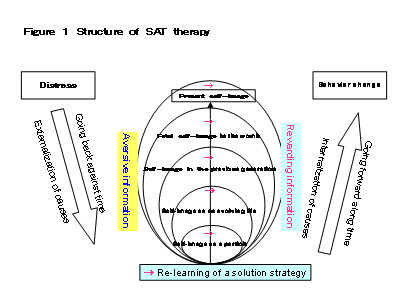
2.2 Problem repeats itself overtime
The specific procedure used in SAT imagery therapy is described in this section using the case of Mrs. A., a uterine cancer patient, as an example. The structure drawing of Figure 1 above is provided to facilitate understanding of the explanation above.
During the therapy, Mrs. A was asked, "How do you want to change so you can become healthy again (self-transfiguration goal)?" She replied, "I want to be a broad-minded person who is not easily upset by little things." However, the degree of her self-confidence was 65%. (In SAT imagery therapy, clients are instructed to indicate how self-confident they are as the degree of self-confidence flashes in their mind.) Then the client was asked to describe the feelings that were blocking her goals by using two categories of visual information: color and shape. Compared with other types of information, visual information is easier to process in the left hemisphere of the brain, the reason being that visual information is easily transformed into somatosensory information. Mrs. A described the feelings blocking her goals as "dark blue and an acute-angled shape." Asked whether she felt anything different in her body when she visualized this particular color and shape, Mrs. A replied, "My breathing becomes unstable and I feel cold." Mrs. A is then instructed to change this somatic sense over to the sense in the womb with the aid of SAT Retrogressive Hypnotherapy. Then Mrs. A communicated a negative womb image: "I can't breathe. The uterine wall looks thick and hard. It's pitch-dark inside the womb." When the question "How do you wish it to be, otherwise" was posed to her, Mrs. A's negative image immediately changed to a rewarding piece of information. The image of her womb changed to "a soft, bright, orange-colored womb." Mrs. A became conspicuously assertive. It seems that those who are usually unwilling to depend on people's kindness are more willing to do so when they regress to their fetus stage in their imagination.
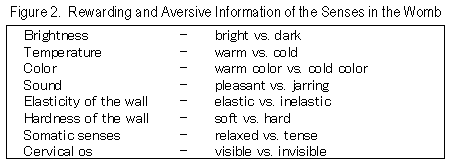
After the client established the rewarding image in the interior of the womb (Figure2), she was encouraged to envision again the aversive image in the womb interior, and with that image as a clue, she was told to start going back again through time and look for the sources of the aversive information. Mrs. A envisioned herself fighting with fellow members of her associates over scarcity of water in the amphibious age. She said, "I'm so anxious and on edge all the time." Mrs. A always looked timid, but she didn't become timid overnight. This is what the author calls the "externalization of the causes."
At this point, Mrs. A was once again led to the rewarding image of the womb interior and asked to describe how the amphibious age should have been established to gain the rewarding image in the womb. Her reply set off a series of changes in the image of the preceding generation, the image of her rearers, and even the image of herself to the rewarding image. Specifically, commenting on the new image of the amphibious age, Mrs. A said, "With plenty of water and food available, I feel relaxed and there is no need to fight with my associates." On the new image of the womb interior, Mrs. A commented, "Mom and dad look dignified and little things don't seem to faze them." The image of the womb interior in the client's fetal period had changed to an ideal image. And finally, regarding her own self-image, Mrs. A said, "I always feel at ease. I even feel a bit adventurous."
The work of "internalization of the problems" is finally taken up. Asked if there was anything in common between her self-image in the amphibious age and her self image in the present age, Mrs. A replied, "I don't live in a good neighborhood," and at the present, "I haven't chosen the job or the workplace I genuinely want." She then added, "First, I'll act, then worry about what might happen, and I'll choose the line of work that best suits me." If Mrs. A follows these steps, she will become "a kind of person who has self-confidence and dignity," the initial goal of her transfiguration.
After Mrs. A formed the image of her rebirth following the change in the image of her rearers, REI was introduced. It was immediately after the formation of the rewarding image by the intervention of the newly introduced REI that the incidence of anti-tumor genes RB and p53 increased in the white cells of Mrs. A's peripheral blood.
While a detailed explanation of the anti-tumor will be given later, Figure 3 below shows the results of Mrs. A's anti-tumor genetic expression test (RT-PCR).

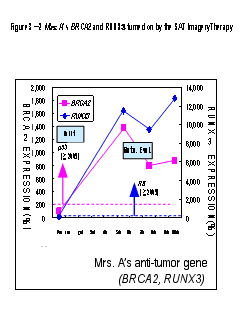
2.3 Memory information before humans became humans
Before continuing with this discussion, it may be a good idea to examine the phenomenon of "past information" in greater detail. Stored information taken up in the SAT imagery therapy has wider and deeper implications than the conventional notion of past information.
Past information is divided into two types of information: explicit and implicit. Explicit information is the past memory information that people have accumulated since around the age of three when they first began talking. This type of information is preserved for 2-3 years as a group of episodes in the hippocampus of the limbic system. After that, only the memory information deemed important is stored in the cerebral cortex.
The latter or implicit information is the information people accumulate in their fetal and infant stages, considerably before they reached the age of three. Some of its contents are stored in the "amygdaloidal body" as somatic sensation information (ache, pain, etc.) and also as emotional information (fear, sadness, etc.), which responds to certain stimulating signals (e.g., sound, expression, action, temperature, humidity, space and sense of equilibrium). Moreover, included in the implicit information is also the record of DNA information, which records the evolutionary process from amino acids to human beings. Furthermore, a human being is basically a complex configuration of atoms composed of as many as 1029 of atoms. The frequency pattern of each individual atom or elementary particle can be regarded as a kind of implicit information.
It is mainly the implicit memory information that is used in the SAT imagery therapy. Specifically, information accumulated during the embryonic and fetal periods - which is said to recapitulate evolution - and information transmitted inter-generationally among ancestors are used, not to mention the information accumulated in the infant period. The information used in SAT imagery therapy is not limited to these two types of memory information. The information used in SAT imagery therapy also includes inter-biologically transmitted information accumulated in the process of pre-human evolution, starting with the age of primates and other animals of the class of Mammalia, Aves and Reptiles, Amphibians, fishes, invertebrata, unicellular organisms like amebas, primitive life like bacteria, organic substances, and even cosmic particles.
Heavy elements - oxygen, carbon, nitrogen, and iron from which the human body is made - were not born in the solar system. They are believed to have come into existence during the supernova that occurred in the universe in distant past. After the cosmic explosion that, according to the big bang theory, marks the origin of the universe, the elemental particles that comprise the atom - proton, nucleus and electron - were created, followed by the creation of light elements like hydrogen and helium. Next, a fixed star was born with hydrogen burning inside. The resultant nuclear fusion of hydrogen atoms led to the creation of helium. The explosion of huge fixed stars eight to thirty times larger than the sun but existing only several hundred millions of years created heavy metals like iron. The earth itself is made up of two large celestial bodies and a countless number of planetesimals that came into existence as a result of a supernova explosion.
Water molecules make up about 70 percent of human body and the oxygen atom from which a water molecule is made is one of the elements emitted into outer space by the force of a supernova explosion. A photograph of atoms shows that each individual oxygen atom has a distinctive shape, which gives form to an electron cloud. Each atom has its own unique frequency pattern. As noted earlier, the human body is made up of 1029 of atoms, and each atom transmits the memory information of evolution as quantum from which an element is formed.
According to a study that earned NASA a Nobel Prize in 2006, the universe was created around 13.7 billion years ago, give or take two hundred million years. The earth was created 4.6 billion years ago, so there is nothing mysterious about the fact that the particle information accumulated since the genesis of the universe should be recorded in the human body as a pattern of frequency. The implicit information used in the SAT imagery therapy includes past information that has been transmitted since the age of cosmic particles by the two nucleobases "A & T" and "G & C" and by DNA, a biopolymer in which the two nucleobases are bonded by hydrogen.
A person weighing 60 kilograms, for instance, is made of approximately 60 trillion cells, and each cell carries some 3 billion pieces of DNA information, of which only about 5-10 percent of the DNA information is related to the formation of arms, legs, internal organs and skin. The remaining 90% or more is the record of the evolutionary information listed below.
- Evolutionary information of amino acid to human beings
- Life-saving information called instinct
- Information concerning viruses and bacteria that have been assimilated or selected in the evolutionary process
- Information concerning poor physical condition or illness together with their treatment experienced in the evolutionary process
- Direction of evolution
Comparing the history of evolution to the stream of a river reveals that once the river is contaminated with wastewater from factories, it is impossible to stem the contamination regardless how hard efforts are made to clean up the water mid- and downstream,. The same is true when people come down with mental and physical problems. Unless the problems are solved by going back to their root, it is almost impossible to solve the problems in the lower reaches of the river.
Each individual has information about his own illness. Incorporated into this genetic information is a mechanism that activates genes of illness and those of health. In many cases, the event which triggered this mechanism occurred in the early evolutionary ages of amebas and organic substances or even the age of cosmic particles before living creature came to the earth. People are apt to doubt any claim that the problems rooted in the course of evolution may be solved by "simply relying on the function of images." However, just as imagining munching a lemon will make one secrete saliva, images are able to bring changes to all organisms including the genetic expression of the body. In cerebrophysiology, it is a known fact that the cerebrum is influenced, regardless of the amount of information, by images, be they real or illusory. Just as images of past nightmares affect the person who had them for the rest of his life, illusory images may also affect the person having them if they are stored in his memory, and possibly affect even the descendants through his behaviors.
It is impossible to confirm whether or not information about a past event is based on actual experience. However, if the client himself has a sense of reality and confidence in that past information, it will have a powerful impact on his real life. Especially, in case of cancer patients, as many cases have demonstrated, it is impossible to eradicate the cause of cancer unless the problem of aversive information in the past evolutionary age restored by regressive hypnosis is solved.
Interestingly, there are certain common images between aversive memory information and rewarding memory information in each age of evolution including the age of womb interior. Human beings are apt to forget that although they have developed an advanced civilization, what human beings as organisms ultimately wish is to be in a situation where everybody is happy and is able to live safely without anxiety, as indicated below This is a situation where, being, surrounded by reliable associates and family, we can get a real feeling of the value of living. What cancer patients lack is precisely this sense of security and reassurance? In fact, tumor suppressor genes start manifesting themselves when a person develops self-images such as "My life is worth living," and "I love my family and other people, and they love me, too."
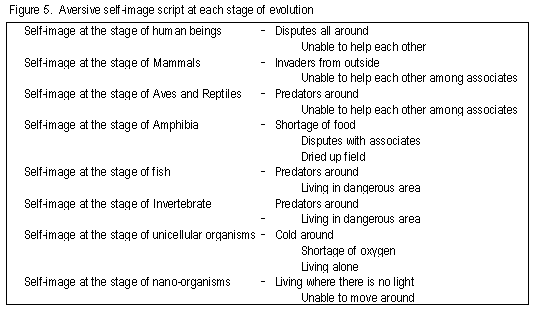
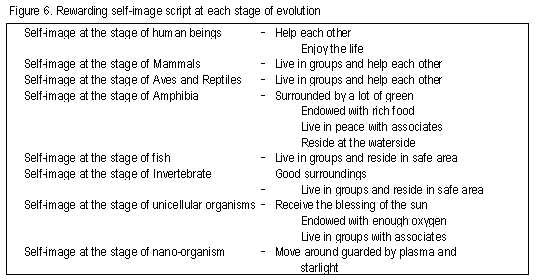
As shown above, the rewarding image in the age of cosmic particles apparently brings a sense of security with the self-image of free motion guarded by plasma and starlight. However, some say they are afraid of starts. They have information that shows them being drawn into such confusion as being struck by a star. Such individuals are encouraged to turn the clock by 13.7 billion years back to the time of the big bang and to recreate a universe where they can feel safe.
2.4 Micro-oscillation moves genes
All molecules of water, which comprise 70 percent of the human body, have plus and minus magnetic poles. These opposite poles cause water molecules to attract and repel each other, and thereby produce vibration. Anesthetics like xenon work by stopping this vibration of water molecules. Any changes in human feelings and sensations may trigger a change in the frequency of protein and water molecules. Placed under general anesthesia, a patient loses all sensation sand feelings. This is because when a patient is under anesthesia the water molecules inside his body are attracted to each other, thus causing the molecules to cease vibrating.
Generally speaking, determining the presence of a medical disorder is the only way to know whether a person is healthy or not. If a person is regarded as a form of energetic substance, then it can be said that information about his health is transmitted from all levels. For instance, if a husband and wife are having a marital issue, there should be a negative vibration observed at the level of molecules.
In SAT imagery therapy, the goal is to activate the client's tumor-suppressing genes by focusing attention on the vibration signal at the molecular level and promoting the transfiguration of the client's feelings and sensations.
Feelings and sensations human beings have are expressed in their eyes, faces, voices and bodily movements. What causes such emotional and physical reactions are the vibration signals that are observed at the molecular level. If these are positive signals, the client's face will look happy. By contrast, if the signals are negative, the client will have a resigned look or a look of anger on his face.
These vibration signals have been handed down through quanta, animals and generations. Many cancer patients have fearful, penetrating eyesight. Such an expression is probably not unique to the present generation but may also be an expression that their parents, grandparents, and even further down their family tree had There is no other way for cancer patients to change their facial expression than to go back to the age of quant and molecules using the REI. Unless patients change the information in the cosmic age, they cannot restore the energy balance necessary to become healthy.

It is this author's hypothesis that genes, as high molecular substances, are activated by resonating with vibrations of atoms and molecules; they do not respond to strong stimuli like anti-tumor agents, which are believed to cause vibration signals. Instead, genes seem to be activated by extremely feeble vibrations.
How can such feeble vibrations be produced? Again it is the author's hypothesis that genes can be activated with thought, image and even skin contact. According to research conducted by this author et al, there are three forms of love, which the author calls the "basic demands: "I want to be loved by people," "I want to love myself," and "I want to love people." When one's thought, image or skin contact become attached to the three forms of love, a vibration is produced in concert with each of these forms of love. And this vibration functions as information to activate genes. If one entertains a rewarding thought and image like "I am loved," this seems to turn the rewarding thought and image into a feeble vibration that activates health-related genes. On the other hand, if one harbors an aversive thought and image like "I'm not worth living," this seems to turn the aversive thought and image into an aversive vibration that activate disease-related genes. As shown in Figure 8 below, rewarding feeble vibrations that activate health-related genes, including anti-tumor genes, have high and spacious amplitude. Expressed in sensory terms, they are "warm" and "fluffy" vibrationsĀBOn the other handĀCaversive vibrations that activate disease-related genes have low amplitude. They are tense and acrimonious. It may be that cancer genes are activated by "panic signals" and "anger signals, which have intense amplitude.
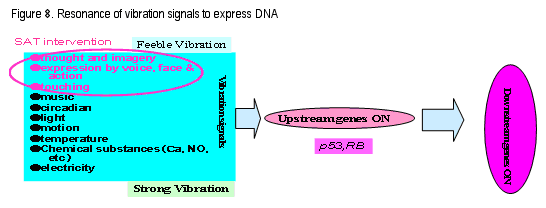
Those with the stress temperament mentioned above seem to have the genes that make them sensitive to tense and acrimonious vibrations. Not only are they sensitive, they themselves constantly send out tense and acrimonious vibration signals. One can easily read these signals in the expression on their faces and in their eyes.
3. Genes of Love
3.1 When a tumor suppressor gene manifests itself
From the viewpoint of physiology, those with stress temperament always stretch their sympathetic nerves. Tense sympathetic nerves increase the number of neutrophils in white blood cells. A high neutrophil count causes overproduction of active oxygen. Overabundance of active oxygen damages tissue cells and DNA and is apt to cause abnormal growth of cancerous cells. The human immune system is supported by the well-balanced ratio of approximately 6 to 4 between neutrophils and lymphocytes (Abo, 1997). But if the proportion of neutrophils exceeds 70 percent, the immunizing strength of lymphocytes, which play a vital role in causing cancerous cells to die, will fall below 1500/É l. As a result, lymphocytes will no longer be able to suppress the abnormal growth of cancer (Abo, 1997).
Anywhere from 2,000 to over 3,000 cancer cells are born and die one after another in the human body every day. Cancerous genes regenerate epitheial cells of tissues and are not necessarily malignant in and of themselves. When these epithelia-generating genes are damaged and no longer able to carry out their normal function, their immunizing strength declines and they lose their capacity to stop the abnormal growth of cancerous cells, which is a very serious situation. It is the lymphocytes, including the NK cells and killer T cells, which destroy these malignant cancer cells. If the state of sympathicotonia last for a long time, the ratio and actual number of lymphocytes decline. Sympathiocotonia also carries with it the risk of leavingĀ@the growth of cancerous genes unchecked.
In the SAT imagery therapy, the treatment for cancer patients aims to enhance both their "immune defense force" and "genetic defense force" by utilizing biofeedback with the data from their blood tests (Figure 9). With regard to the immune defense force, the targets are 2000/É l for the number of lymphocytes in a white blood cell and 35 to 41 percent for the ratio of lymphocytes, and 30 to 70 percent for the ratio of the activated NK cells.
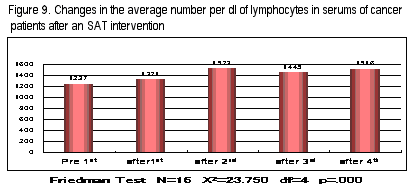
In a recent study using knockout mice (i.e., mice in which a particular gene has been artificially destroyed and made dysfunctional), it is reported that genes were rendered cancerous by making 'p53' and 'RB' dysfunctional (Morgenbesser et al.. 1994). In the SAT therapy, genetic defense force is used as an indicator when the four cancer suppressor genes - the two genes plus 'BRCA2' and 'RUNX3' - are turned on. (The moment the amount of messenger RNA more than doubles is regarded as the baseline for judging manifestation of genetic defense force). The goal of SAT therapy, for the time being, is to lower the tumor marker, but its ultimate goal is to cause the disappearance, contraction or cessation of the progress of cancer in an X-ray examination, an echo graphic investigation, or a tissue test.
| p53 normal | p53 abnormal | |
| RB normal | Stem growth | Stem growth |
| RB abnormal | Apoptosis | Make cancerous |
In the SAT imagery therapy for cancer patients, the four cancer suppressor genes are used as indicators of genetic defense force (Figure 11). This author calls them "Genes of Love," for they manifest themselves in response to satisfaction with the said three types of demands for love. From the cases treated thus far, as introduced below, a certain amount of regularity has been found between tumor suppressor genes and love.
BRCA2 is turned on when the demand for being love by others is fulfilled. This is the "Passive Love Gene" that is closely related to breast, ovarian and other cancers peculiar to women. It has a tendency to manifest itself when one becomes firmly convinced that one is loved by those whom one cherishes.
RB is turned on when the demand for self-love is fulfilled. It is related to all types of cancer, but especially to the cancer of eyes and pancreas. This is the "Self-Love Gene that manifests itself in those who love themselves as they are oblivious to how others may judge them. RB manifests itself when one starts having self-confident.
p53 is turned on when the demand for loving others is fulfilled. This is the "Positive-Love Gene" that stops the division of cancer cells and suppresses the generation of new blood veins that leads to cancer cells. p53 shows a tendency to manifest itself when one forgives and loves one's rearers, spouse and children.
RUNX3 is turned on when the prospects are bright for loving oneself and loving others. This is the "Love-Coherence Gene" that is related to cancers of the stomach, duodenum and other digestive organs. RUNX3 has a tendency to manifest itself when the prospects are bright for loving oneself and loving others, but in some cases, it turns on and off repeatedly as prospects often depend on objective factors.
Cancer patients often say, "It is important to have a sense of gratitude." Perhaps having a sense of gratitude and revering others helps fulfill their wish to be loved. As long as one continues to demand others love them saying, "Please do as I say" and "Please accept me," one cannot hope to be loved in the way one expects. On the other hand, by just being grateful for the very existence of one's partner and adoring his or her personality, the partner will also begin to love one unconditionally. This is how love seems to work.
When the demand for being loved is fulfilled, it becomes easier to turn on the tumor suppressor gene BRCA2. BRCA2 is a gene that is related to breast cancer and uterine cancer. Thus this author calls it "Passive Love Gene." In terms of fulfillment-of-the-demand principle, when the demand for affection is fulfilled, the demand for self-reliance grows. At this point, one will be able to start living a satisfactory life, enjoying oneself just the way one is, regardless what others may say, and as a result, it becomes easier for RB to turn on. Since loving oneself makes it easier for RB to manifest itself, the author names this "Self-Love Gene." When one learns to love oneself, the desire to love others starts to grow, thus making it easier for p53 (Positive Love Gene) to turn on. Furthermore, if the prospect for loving oneself and loving others is good, it will become easier for RUX3 (Love Coherence Gen) to turn on.
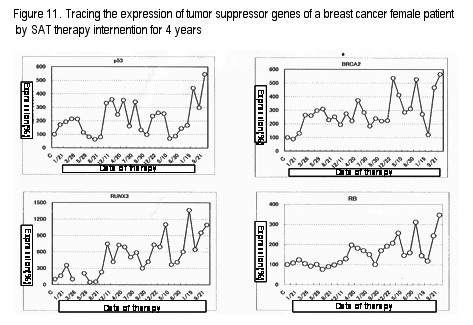
3.2 Retrospective Evolution Imagery Therapy
Forming a rerearing image in which one is loved by the rearer and lives trying to satisfy oneself by fulfilling one's affection-seeking demands and self-reliance demands enables one to reach a state in which one is able to enjoy one's true self. Then BRCA2 starts activating and RB follows suit, but no further development is observed. p53, the positive love gene, and RUNX3, the love coherence gene, do not readily express themselves. Studies have shown that in such cases, one who holds aversive images of pre-human ages cannot be healed by merely changing those memory images.
The aforementioned Retrospective Evolution Imagery (REI) was developed as a new method for effectively treating such cases as well. In REI therapy, one's image is taken back to the ancient, pre-human ages such as the age of monkeys and other animals of the class of Mammalia, Aves and Reptilia, Amphibia, fish, invertebrata, unicellular organisms like amebas, primitive life like bacteria, organic substances, and even cosmic particles. One's negative image memory is then changed to a positive one. As a result, the demand for loving others, to say nothing of the demand to be loved, is fulfilled, at which time the rate of expression of all four types of tumor suppressor genes is also increased.
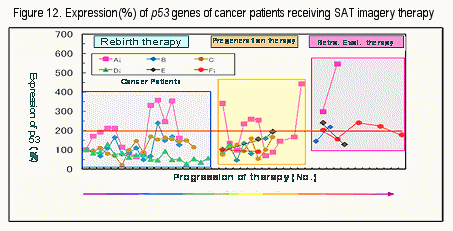
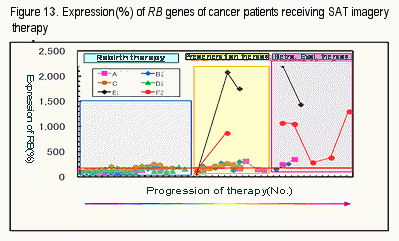
As is shown in Figure 12, 13, in the rebirth imaging therapy, sometimes it takes more than one year for p53 and RB genes to express themselves. However, in the RE imagery therapy, p53 and RB genes express themselves immediately after the first intervention.
Many patients resign themselves to the notion that cancer is fatal saying, "We have a family history of cancer." These patients are convinced that they are destined to die from cancer because many in their family line over generations to say nothing of parents, siblings and relatives died from cancer. The effect of the therapy will be limited if the change is made in the memory image of only a few generations including their parents and grandparents. Perhaps deep down they are desperately resigned to the whims of the old genes that they have succeeded from primitive human beings. Even in such cases, the ratio of expression of tumor suppressor genes will be dramatically increased if they change the process of evolution before the age of human beings or the memory information image of molecules and atoms, which triggered the creation of DNA itself in the first place.
Another case of RE imagery therapy (in addition to the case of patient A) drawn from the files of SAT imagery therapy is taken up below. In this case, by changing the aversive memory information image from the biological age, the client became aware of the feeling of resignation that had dominated her, and was therefore able to change the way she lives.
| Counselor: | If you were asked to recall the aversive sensation of the womb interior that you experienced, what sort of problems comes to your mind and from what age? (When the counselor asks the client to recall the aversive images of the womb interior and say the names of the ages as they appear in her mind, the images of the interior of the womb naturally become visible) |
| Client: | I can see myself in the blue ocean. I'm a shellfish. |
| Counselor: | So you are a shellfish in the blue ocean. Is there any enemy? |
| Client: | Yes, there is. It feels like I'm being attack by a starfish. It's really scary. |
| Counselor: | In the age of amebas, you had an image of being with associates, didn't you? The sun is shining, and there's plenty of oxygen in the air (prior to this, the clients recalls the ameba age). Imagine that tribe evolving into shellfish. What happens to the shellfish? |
| Client: | Before, they went on their separate ways, but now they coexist as friends. |
| Counselor: | When the shellfish coexist as friends, what happens to the image of the womb interior? |
| Client: | The image is calm. It feels good. |
| Counselor: | Are there any similarities between the problems in the shellfish age and those you are face with now? If yes, what are they? Please tell me what flashes in your mind. |
| Client: | The reason I became a shellfish was to protect myself from foreign enemies. Through successive generations, I gradually grew a protective shell around my body. Although I protected myself this way, I was nearly devoured by a starfish. I was bitterly disappointed. All the work I had put in was for naught. I think that that bitter sense of failure is what brought about today's resignation. "Oh, to heck with it. Who cares? |
As discussed earlier, the human body (about 60 kilograms in weight) consists of approximately 60 trillion cells. This simply means that beings are organisms that cannot live alone. The image of a loner, for any family in the process of evolution, is always an aversive one, even at the level of molecules, atoms, and an atomic nucleus. If one has an image of fighting among one's associates, however many there may be, the image of the cells that make up one's body will also show them fighting among themselves. This is exactly the same image as the one for cancer itself.
As was introduced earlier, the conditions of ideal environment differ from one stage of evolution to another. It may safely be said that to have associates, and to live amicably with them, has been the indispensable condition for protecting life in any age. The memory information of an age when this condition was not fulfilled is what makes one's present self-image negative and what keeps undermining one's health.
3.3 Imperturbable relationship of Amor fati
In case not only of cancer but also of illness in general, it seems that not being able to establish a good relationship with an Amor fati partner plays a crucial role in life. The relationship of Amor fait, in a word, is one in which two people hand-in-hand overcome difficulties. In such a relationship, one never forsakes one's partner under any circumstance, and even puts one's life on line to save one's partner. The partner of Amor fati is not necessarily limited to one's family such as one's mother or spouse, but in certain cases includes one's friends and mentors. If one is unable to establish amicable relationship with such a partner, then the stress caused by this situation will, in the long run, trigger obstacles to one's life and spirit.
Many cancer patients become obsessed when they are unable to establish a good relationship with a partner of Amor fait. Many cases have been observed where cancer suppressor genes were expressed as a result of successfully establishing a good relationship with a partner of Amor fati, or where, although the patient died of cancer, his soul was saved so that at least his quality of life was significantly improved.
In many cases, cancer patients have deep suspicion of people around them. Some of them have given up loving others as well as being loved by others. They are unable to build a relationship of Amor fati though they long for such a relationship. Despite the fact it treats images of pre-human ages, treatment of even these patients has produced impressive results with the application of the RE imagery therapy, The suppressor genes p53, which are activated by loving others, are usually very difficult to activate in cases involving patients with deep suspicion of other people. With the intervention of the images acquired in the RE imagery therapy, however, the rate of p53 expression, which up to now has never been raised, is dramatically raised.
Human beings are creatures that seek to find the meaning of life from the time they are born to the time they die. The relationship of Amor fati may be the relationship that proves that one came into this world as a human being. This is why at times human beings will even risk their life to develop such a relationship.
Many people, when diagnosed with cancer, explode in anger against the unfair fate claiming, "Why in the world should IĀc?" Having seen so many cancer patients, this author is convinced more than ever that cancer is a disease that pushes them to achieve self growth. Since it is the patient himself who desires to achieve self growth, to the patient cancer is a test that he himself invited. Of course, at first, most patients are reluctant to accept such an outrageous argument, but gradually they learn the joy of being loved and become aware of the pricelessness of loving oneself and loving others, and as they attain personal development, many even insist in earnest that they are pleased to have developed cancer.
One patient described his feelings about cancer as follows:
When I think about it now, I was lucky to have experienced becoming a cancer patient and then encountering the SAT imagery therapy. Through these experiences, I think I've changed in the following way:
In the past, I always tensed up when I was with anyone. And if it lasted long, I tended to become tired. Otherwise, I wanted to be with other people. Nowadays, I have a sense that I'm more connected with people and things, and therefore, I can feel myself relaxed even when I'm with others for a long time.
In the past, I used to spend all my time just for myself. I seldom ever spent any time helping others. Also, I rarely ever visited anyone in the hospital. Nowadays, I often visit hospitals to help others, and I often share time with my old parents at their home. Somebody once said, "You become strong when you work for other people." The converse can also be said, "You become weak when you work only for yourself." My ideal is to become strong and gentle.
I want to be smiling always. To tell you the truth, I actually like smiling and I enjoy being jolly. In the past, little things used to cloud my mind. Nowadays, I've learned to change my mind as soon as I feel myself falling into a dark mood. I feel now that with proper training I'll be able to control my mind by myself. If I can keep living with this positive attitude, I believe I'll be able to cut off all ties with cancer. Even if I can't always be so positive, I'm satisfied with this life of mine.
We often hear people say, "Once you have removed the cause of cancer surgically, somatically you will no longer have anything to worry about." The present author does not support this view. Even if one recovers from cancer in one's youth, if one does not change one's way of thinking and continues to be under the same stress that triggered the disease in one's youth, cancer may express itself again in the form of cardiovascular and other diseases when one gets older and grows feeble. "Live and let live" is my motto. As the saying goes, "You die as you live."
O.K.'ing oneself will have a positive effect on those around one. Living cheerfully, without hang-ups may have a good effect on one's family, friends, acquaintances, communities, and even the world at large. Individual human beings may be but a spec in the vast universe, but it is this author's belief that one can make a big difference for those around one just by living a life that is true to one's genuine self.
BIBLIOGRAPHY
- Abo, T. (1997) Future Immunology. Tokyo: Intermedica.
- Comings, D.E. et al. (2000) A multivariate analysis of 59 candidate genes in personality traits: theĀ@ temperament and character inventory, Clin. Genet 58: 375-385.
- Kobayashi, K., Hashimoto, S., Hayashi, T., Sakamoto, S., Hori, M., Obitsu, R., Murakami, K., and Munakata, T. (2006). Treatment for Inter-generationally Transferred Feelings of Cancer Patients Using Seasonal Changes of Immune Data as a Clue : Stress Image Shown as Somatic Symptoms in the Blood Data in the Key State of Summer Season. Journal of Health Counseling: 12:37-45.
- Li, Q.L., Ito, K. et al. (2002). Causal relationship between the loss of RUNX3 expression and gastric cancer. Cell 109, 113-124.
- Maeda, T., and Munakata, T. (2005). The study from the viewpoints of behavioral science on self-care behavior and psychological factors of patients in the telemedical period following the excision of stomach. The Clinical Nursing 31(7): 1120-1126.
- Maeda, T., Hashimoto, S., and Munakata, T. (2006). Trial Invention of the SAT Therapy to Cancer Patients. The Cancer Nursing 10(5): 4536-459.
- Maeda,T., Onuoha, F.N., and Munakata, T. (2006) The Effect of Postoperative Symptom Experience, and Personality and Psychosocial Factors on Depression Among Postgastrectomy Patients in Japan. Gastroenterology Nursing, 29 (6): 437-444.
- Morgenbessor, D., B. O. Williams, T. Jacks & R. A. DePinho (1994) p53- Dependent Opoptosis Produced by Rb-deficiency in the Developing Mouse Lens. Nature 371(1): 72-74.
- Munakata, T., Kobayashi, K., Hashimoto, S., Maeda, T., Hatsuya, T., Kadoi, S., Ohkubo, Y., Mochida, M., Hayashi, T., Obitsu, R., Shouji, S., & Murakami, K. (2004). A Case of Breast Cancer Patient Whose Activation of Tumor Suppressor Genes and Immune Strength were Raised by Intervention of SAT Imagery Therapy. Journal of Health Counseling: 10:61-68.
- Munakata, T. (2005) SAT Imagery Therapy - Therapy of Love to Save the Family with the Patient of Cancer and Depression. Tokyo: Shufu to Seikatu Sha.
- Munakata, T. (2005) SAT Therapy. R. Obitsu (Ed.), Encyclopedia of Home Care for Cancer Tokyo: Futami Shobou, pp142-145.
- Munakata, T. (2004). In T. Munakata (Ed.), Practical Methods Health Counseling Based on the SAT. Counseling Treatment and Health. Tokyo: Kaneko Shobou, 2004, pp3-25.
- Munakata, T., Kobayashi, K., Hashimoto, S., Maeda, T., Hatsuya, T., Shouji, S., Obitsu, R., Mochida, M., Hayashi, T., & Murakami, K. (2004). Expression of Tumor Suppressor Genes by the SAT Imagery Therapy. T. Munakata (Ed.), Counseling Treatment and Health. Tokyo: Kaneko Shobo, pp57-71.
- Munakata, T. (2006). The Concept of Image Script Integrating EBM and NBM. Journal of Health Counseling: 12:9-18.
- Munakata, T. (2006). SAT Therapy. Tokyo: Kaneko Shobou.
- Munakata, T. & K. Kobayasi (2007). SAT Therapy Expressing Anti-tumor Genes. Tokyo: Sinjyu Sha, 2007.
- Van den Bergh, B. R. H., & Marcoen, A. (2004). High antenatal maternal anxiety is related to ADHD symptoms, externalizing problems, and anxiety in 8 and 9-year olds. Child Development, 75(4), 1085-1097.
- Comings, D. E., Gade-Andavolu, R. et al. (2000). A multivariate analysis of 59 candidate genes in personality traits: the temperament and character inventory, Clinical Genetics 58, 375-385.
- Temoshok, L., & Dreher, H. (1992). The Type C Connection: The Behavioral Links to Cancer and your health, Random House.